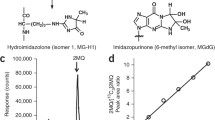Abstract
The determination of methylglyoxal (MG) concentrations in vivo is gaining increasing importance as high levels of MG are linked to various health impairments including complications of diabetes. In order to standardize the measurements of MG in body fluids, it is necessary to precisely determine the concentration of MG stock solutions used as analytical standards. The “gold standard” method for the determination of MG concentration in the millimolar range is an enzyme-catalyzed endpoint assay based on the glyoxalase I catalyzed formation of S-lactoylglutathione. However, as this assay used purified glyoxalase I enzyme, it is quite expensive. Another method uses a derivation reaction with 2,4-dinitrophenylhydrazine, but this substance is explosive and needs special handling and storage. In addition, precipitation of the product methylglyoxal-bis-2,4-dinitrophenylhydrozone during the reaction limits the reliability of this method. In this study, we have evaluated a new method of MG determination based on the previously published fast reaction between MG and N-acetyl-l-cysteine at room temperature which yields an easily detectable condensation product, N-α-acetyl-S-(1-hydroxy-2-oxo-prop-1-yl)cysteine. When comparing these three different assays for the measurement of MG concentrations, we find that the N-acetyl-l-cysteine assay is the most favorable, providing an economical and robust assay without the need for the use of hazardous or expensive reagents.

Comparison of the three different spectrophotometrical methods of MG determination


Similar content being viewed by others
Abbreviations
- 2,4-DNPH:
-
2,4-Dinitrophenylhydrazine
- MG:
-
Methylglyoxal
- ε :
-
Molar absorption coefficient
References
Phillips SA, Thornalley PJ (1993) The formation of methylglyoxal from triose phosphates. Investigation using a specific assay for methylglyoxal. Eur J Biochem 212:101–105
Zou Z, Wu L, Ding H, Wang Y, Zhang Y, Chen X, Zhang CY, Zhang Q, Zen K (2012) MicroRNA-30a sensitizes tumor cells to cis-platinum via suppressing beclin 1-mediated autophagy. J Biol Chem 287:4148–4156
Chaplen FW, Fahl WE, Cameron DC (1996) Detection of methylglyoxal as a degradation product of DNA and nucleic acid components treated with strong acid. Anal Biochem 236:262–269
Wang J, Chang T (2010) Methylglyoxal content in drinking coffee as a cytotoxic factor. J Food Sci 75:H167–171
Thornalley PJ (1993) The glyoxalase system in health and disease. Mol Aspects Med 14:287–371
Brownlee M (1995) Advanced protein glycosylation in diabetes and aging. Annu Rev Med 46:223–234
Ohmori S, Mori M, Kawase M, Tsuboi S (1987) Determination of methylglyoxal as 2-methylquinoxaline by high-performance liquid chromatography and its application to biological samples. J Chromatogr 414:149–155
Espinosa-Mansilla A, Duran-Meras I, Salinas F (1998) High-performance liquid chromatographic–fluorometric determination of glyoxal, methylglyoxal, and diacetyl in urine by prederivatization to pteridinic rings. Anal Biochem 255:263–273
Lapolla A, Flamini R, Tonus T, Fedele D, Senesi A, Reitano R, Marotta E, Pace G, Seraglia R, Traldi P (2003) An effective derivatization method for quantitative determination of glyoxal and methylglyoxal in plasma samples by gas chromatography/mass spectrometry. Rapid Commun Mass Spectrom: RCM 17:876–878
Nemet I, Varga-Defterdarovic L, Turk Z (2004) Preparation and quantification of methylglyoxal in human plasma using reverse-phase high-performance liquid chromatography. Clin Biochem 37:875–881
Espinosa-Mansilla A, Duran-Meras I, Canada FC, Marquez MP (2007) High-performance liquid chromatographic determination of glyoxal and methylglyoxal in urine by prederivatization to lumazinic rings using in serial fast scan fluorimetric and diode array detectors. Anal Biochem 371:82–91
Racker E (1951) The mechanism of action of glyoxalase. J Biol Chem 190:685–696
Gilbert RP, Brandt RB (1975) Spectrophotometric determination of methyl glyoxal with 2,4-dinitrophenylhydrazine. Anal Chem 47:2418–2422
Lo TW, Westwood ME, McLellan AC, Selwood T, Thornalley PJ (1994) Binding and modification of proteins by methylglyoxal under physiological conditions. A kinetic and mechanistic study with N alpha-acetylarginine, N alpha-acetylcysteine, and N alpha-acetyllysine, and bovine serum albumin. J Biol Chem 269:32299–32305
Thornalley PJ (1990) The glyoxalase system: new developments towards functional characterization of a metabolic pathway fundamental to biological life. Biochem J 269:1–11
Krizner HE, De Haan DO, Kua J (2009) Thermodynamics and kinetics of methylglyoxal dimer formation: a computational study. J Phys Chem A 113:6994–7001
Ferguson GP, VanPatten S, Bucala R, Al-Abed Y (1999) Detoxification of methylglyoxal by the nucleophilic bidentate, phenylacylthiazolium bromide. Chem Res Toxicol 12:617–622
Zeng J, Davies MJ (2005) Evidence for the formation of adducts and S-(carboxymethyl)cysteine on reaction of alpha-dicarbonyl compounds with thiol groups on amino acids, peptides, and proteins. Chem Res Toxicol 18:1232–1241
Acknowledgments
We gratefully acknowledge the financial support of the NHMRC (grant IDs: 436797, 606543, 1046227). We also thank Dr. Michael Muller for expert advice.
Author information
Authors and Affiliations
Corresponding author
Rights and permissions
About this article
Cite this article
Wild, R., Ooi, L., Srikanth, V. et al. A quick, convenient and economical method for the reliable determination of methylglyoxal in millimolar concentrations: the N-acetyl-l-cysteine assay. Anal Bioanal Chem 403, 2577–2581 (2012). https://doi.org/10.1007/s00216-012-6086-4
Received:
Revised:
Accepted:
Published:
Issue Date:
DOI: https://doi.org/10.1007/s00216-012-6086-4




